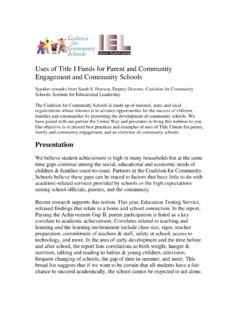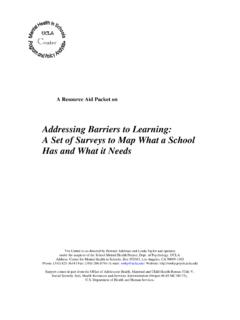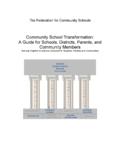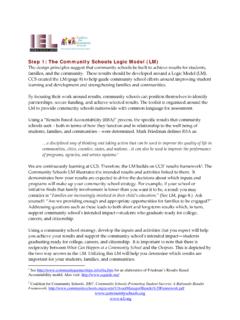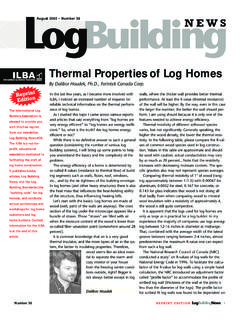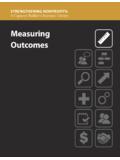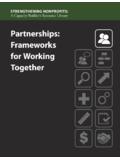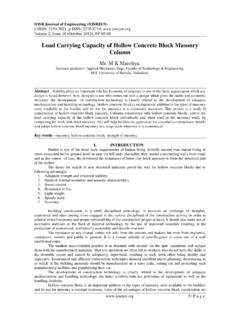Transcription of EDUCATION ANDCOMMUNITY BUILDING
1 EDUCATION . AND. COMMUNITY. BUILDING . Connecting Two Worlds Institute for Educational Leadership About IEL. For more than thirty-five years, the Institute for Educational Leadership (IEL) . a nonprofit, nonpartisan organization based in Washington, DC has worked to achieve better results for children and youth. At the heart of our effectiveness is our unique ability to bring people together to identify and resolve issues across policy, program and sector boundaries. As a natural outgrowth of our work, we have created and continue to nurture diverse networks across the country. Today, IEL is working to help individuals and institutions increase their capacity to work together. We are BUILDING and supporting a cadre of diverse leaders, strengthening the capacity of EDUCATION and related systems, and inform- ing the development and implementation of policies.
2 Our efforts are focused through five programs of work Developing Leaders; Strengthening School- Family-Community Connections; Governing; Connecting and Improving Systems that Serve Children and Youth; Improving Preparation for Work. Please visit our Web site at to learn more about IEL. Ordering and Contact Information Copies of this report are available for $ Orders must be received in writing by fax, e-mail, or mail. To order copies, contact: The Institute for Educational Leadership 1001 Connecticut Avenue NW, Suite 310. Washington, DC, 20036. Tel: (202) 822-8405. Fax: (202) 872-4050. E-mail: 2001 by the Institute of Educational Leadership, Inc. All rights reserved. No part of this document may be reproduced in any way without the express written permission of the publisher.
3 ISBN Number: 0-937846-20-1. EDUCATION . AND. COMMUNITY. BUILDING . Connecting Two Worlds Jeanne Jehl Martin J. Blank Barbara McCloud Editor: Atelia I. Melaville With the support of the Rockefeller Foundation 1. 2. PREFACE. Michael D. Usdan, President, IEL. IEL's vision is of a society that uses its resources effectively to achieve better results for children and families. We believe that educators and community builders need to find new ways to bridge the existing chasm between them and to create relationships that bring their mutual resources to bear on student learning. This report represents an important, if not pioneering, effort to connect these two worlds. BUILDING these kinds of connections and relationships is at the heart of the work of the Institute for Educational Leadership (IEL).
4 Efforts throughout the country to strengthen standards, assessments and accountability in our public EDUCATION system are long overdue, particularly in economically disadvantaged urban and rural areas in which academic expecta- tions often have been low. Few question the assertion that the transcendent mission of the schools is to promote student learning, but there is growing recognition that in too many cases the emphasis on academics alone will not be sufficient. Too many children come to school with social, health and economic problems that detract from their ability to achieve academically. Since the school has social penetration and community outreach unrivaled by any other institution, it is logical to expect it to play some role in ameliorating the negative life conditions that confront so many children.
5 But schools cannot, and indeed must not, do this work alone. At the same time, communities are increasingly concerned about the low performance of their schools. Parents, neighborhood residents and community organizations are asserting that they must have a larger role in reforming our nation's public schools. Schools are viewed as centers of community and commu- nity builders want a hand in their reform and revitalization. We are not suggesting that the primary educational mission of schools should be compromised. Rather, we are suggesting that there is a need for new financial, governance and program partnerships between schools and community groups. The position of the Committee for Economic Development (CED), a prestigious group of business leaders, is correct.
6 In its 1994 report Putting Children First, CED, endorsed the paramount academic focus of the schools, but acknowledged the reality that schools for many students were the logical site for the provision of other essential community services. These issues have unprecedented saliency today because of the needs of our increasingly diverse student population. In 1983, A Nation at Risk effectively raised public consciousness and ulti- mately much action on the need to improve the academic performance of schools. A recent and much less heralded report by the Century Fund, creatively dubbed A. Notion at Risk, raised anew the alarming notion that American EDUCATION , in some cases, is having the effect of reinforcing existing inequalities, particularly in high poverty schools.
7 This IEL report, EDUCATION Reform and Community BUILDING : Connect- ing Two Worlds, breaks new ground by helping dedicated educators and commu- nity individuals understand and respect the assets and talents that each brings to the goal of improving student learning. 3. ACKNOWLEDGEMENTS. On behalf of the Institute for Educational Leadership, I wish to thank many different people who have helped to make our idea that educators and community builders need to learn about and from one another a reality. First and foremost are the community builders and educators with whom we spoke. They all demonstrated extraordinary commitment to our nation's children, but equally important in this context, a willingness to explore new ways that they can work together in the future.
8 We are especially indebted to leaders from the Chula Vista (CA) School District, the Logan Square Neighborhood Association and the Chicago Public Schools, the Marshall Heights Community Development Organization and the District of Columbia Public Schools, and the Germantown Settlement House and the Philadelphia Public Schools; they allowed us to look in depth at their working relationships in their schools and communities. We are grateful for the support of the Rockefeller Foundation which financed this project from both its EDUCATION and community BUILDING budgets. Thanks to Julia Lopez, Director of Equal Opportunity and Frederick Frelow, EDUCATION Program Officer. In addition, we wish to thank Angela Glover Blackwell, Chet Hewitt, Jamie Jensen, David Maurrasse and Marla Ucelli, formerly with the Foundation, who contributed to the project.
9 We appreciate the assistance and support of the National Community BUILDING Network (NCBN) and its Executive Director, Sheri Dunn Berry, who showed interest in this study from its inception, suggesting names of interviewees and allowing us to explore the issues of community BUILDING and EDUCATION at the NCBN national conferences. Special thanks are due to Jeanne Jehl, senior author of this report. Jeanne did a masterful job of pulling together a set of diverse ideas into a coherent document. Her experience as a practitioner in the EDUCATION world, and involvement with community, made Jeanne the right person to help bridge the gap between educa- tion and community BUILDING . Barbara McCloud tapped into her extraordinary relationships among educators across the country to help identify interviewees for the study, conduct interviews and field visits, and organize the dialogue we con- ducted at the Rockefeller Foundation.
10 Tia Melaville played her usual effective role in sharpening all of our thinking as she edited the final draft. Denise Slaughter and Sharon Davis provided research and logistical support for the project. Melyssa Sheeran and Jessica Deutsch assisted with final production. Finally, I wish to thank my colleagues at the Institute for Educational Leader- ship. IEL is a unique organization that always works and thinks across boundaries. In a real sense, that is why we have prepared this paper. We trust it will motivate more educators and community builders to span boundaries and work together in the future. Martin J. Blank Director, Community Collaboration TABLE OF CONTENTS. INTRODUCTION 1. STARTING POINTS: Where Schools and Community Builders Begin 3.

